 Hydrangea is a perennial garden plant, deservedly popular: it pleases with abundant flowering in spring and summer, flowers have a variety of colors, bushes with beautiful large flowers will revive any corner of the garden area.
Hydrangea is a perennial garden plant, deservedly popular: it pleases with abundant flowering in spring and summer, flowers have a variety of colors, bushes with beautiful large flowers will revive any corner of the garden area.
Flowering for such a long time requires constant replenishment of nutrients in the soil, fertilizing them helps to fill.
Content
Feeding calendar
During planting, 1 cup of superphosphate and 30 g of potassium sulfate are introduced, 30 g of ammonium sulfate are additionally added during planting in the spring. Further top dressing is not carried out for 2 years, then alternate organic and mineral top dressing.
When and how to feed:
- nitrogen fertilizers are applied from spring to mid-summer once every 2 weeks;
- do not use nitrogen from mid-July;
- water the entire bush with a solution of manganese (0.2 g per 1-l) once a month - it strengthens tissues well;
- the formation and growth of buds require the introduction of potassium sulfate and superphosphate (40 and 60 g per 10 l);
- top dressing is stopped at the end of August.
If regular fertilizing is not possible, it is recommended that after the soil has been cleared of snow, granules of complex fertilizers are added by deepening them. Expenditure will occur gradually, providing the plant with nutrition all, and sometimes not just one, of the season. Then mineral fertilizing is no longer necessary.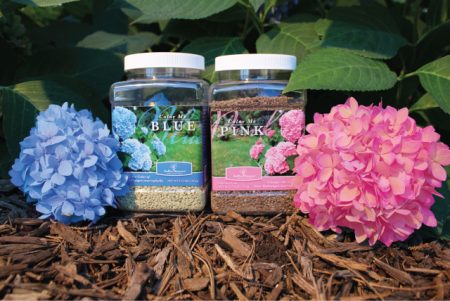
Types of mineral dressing
For the application of mineral substances, fertilizing with several fertilizers with one basic substance or fertilizers with a complex of substances is suitable. Complex fertilizers are more convenient to use - the doses have already been calculated in the instructions.
Options for complex fertilizers:
- Fertika - in liquid form, apply 1 time in 2 weeks while growth is in progress, granules are applied under the bush up to 2 times per season;
- Pokon acts for a long time, use a single application in the spring;
- GreenWorld is used up to 2 times per season for abundant bud formation, long flowering and bright coloring of flowers.
Ammonium sulfate (60 g), potassium sulfate (15 g) and superphosphate (20 g), diluted in 10 l, have an effective effect during the growing season (May-June).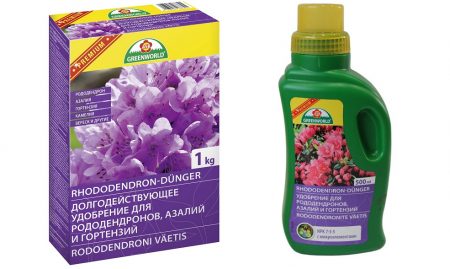
Organic fertilizer
Organics are not always recommended. The best option is to alternate it with mineral dressings. The choice depends on your capabilities - you can not always find manure or mullein.
Options for organic dressing:
- Infusion of manure: in manure (1 part) add water (3 parts) and soak in the shade for a week. For watering, use a 1:10 solution.
- Mullein infusion: Fill a third of the capacity with fresh mullein and add water to the full volume. The duration of the preparation depends on the composition of the mullein. Most often, the process lasts 5-7 days. Infusion for watering is bred in a proportion of 1:10. Add top dressing to grooves dug at a distance from the stem.
- Infusion of greens: put weed grass in any container, completely fill with water and leave warm for fermentation. When the foam disappears from the surface - the infusion is ready. Bred for watering 1:10.
- The preparation of vermicompost in solution.
- The introduction of humus under the bush in the fall will protect against frost, and in the spring it will replenish the soil with nitrogen.
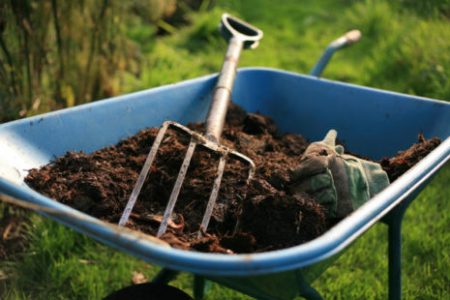
Fertilizers in the spring at different periods of growth
Fertilizer application time affects their composition and dosage.The abundant long flowering, beautiful appearance of the bush and resistance to diseases are affected by a combination of top dressing.
Top dressing in the spring
With the onset of heat, hydrangea begins to grow rapidly, grows green mass, buds are planted, and nitrogen is needed for this. Potassium sulfate and urea (1 tbsp. Per 10 l) will fill its deficiency, the consumption rate is 0.5 buckets per bush. As a nitrogen top dressing, a solution of slurry 1:10 is very effective.
When buds are formed, phosphorus-potassium fertilizers are needed: ammonium sulfate (60 g), potassium sulfate (15 g), superphosphate (20 g) per 10 l. Consumption per plant - 2-3 buckets.
How to change hydrangea color
The property of hydrangea to change the color of flowers attracts flower lovers. Anthocyanins, substances in the composition of cell juice, set the tone for color. They change when they react with metal ions contained in the soil, which entails a change in the color of the inflorescences. Neutral or alkaline soil (pH = 7-8) gives the flowers a pink color, acidic (pH = 2-4.5) medium makes them blue or blue-violet, slightly acidic soil (pH = 5-6) makes the flowers white.
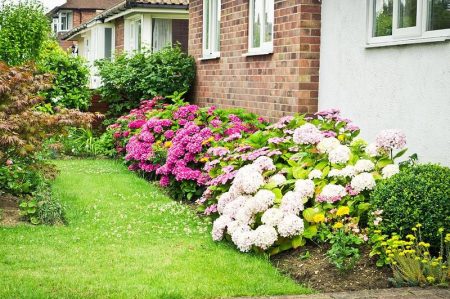
Litmus, an indicator of acidity, will help to find out the acid composition of the soil. It is sold in pharmacies, in stores, easy to use. The acidity of the soil is regulated, and it can be changed by the introduction of certain substances.
General rules for fertilizing:
- comply with the required dosage;
- sick and weak plants should not be fed;
- fertilizers to be applied to moist soil;
- acidic environment is supported by mulch from peat, pine bark;
- expanded clay, marble chips are not recommended for use in mulching.
Getting blue coloring
In slightly acidic soil (pH = 5-6), metal salts are contained in soluble form and are well absorbed by the plant. At pH≥5.5, transitional colors with purple hues appear.
What to do:
- To bring aluminum sulfate in the dry form into the soil - up to 0.5 kg per 1 m². In a solution (30-40 g per 10 l), water at least once every 1-2 weeks. In the same proportion, potassium alum is used. For an adult bush, 2-3 buckets of solution are needed.
- The acidity of the soil under the bush can be increased to the desired values during planting by adding horse peat or elemental sulfur.
- To support the resulting color, apply fertilizers, where potassium is much more phosphorus. For example, apply ammonium sulfate - 15 g per 1 liter. Superphosphate is not suitable for these purposes.
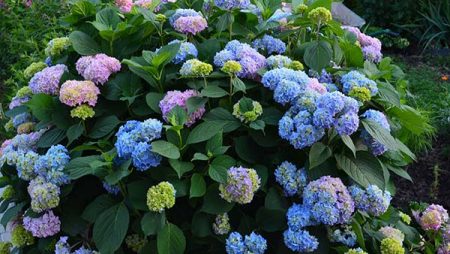
Pink hydrangea
The pink color of the inflorescences is obtained at pH = 7-8 - with such acidity, metal salts are not absorbed, so the blue (blue) color will not work.
Procedure:
- If the indicators meet these standards, you need to monitor the condition of the plant and, if necessary, scatter metal filings under the bush, stick nails into the ground - sometimes there is a lack of iron with this soil composition.
- Lime, dolomite flour, ground limestone, introduced into the soil 2-3 times per season, will help bring the indicators to the desired level.
- Use monophosphate, which contains a lot of potassium and phosphorus - it converts aluminum into forms that are difficult to assimilate by the plant, which is why it turns pink.
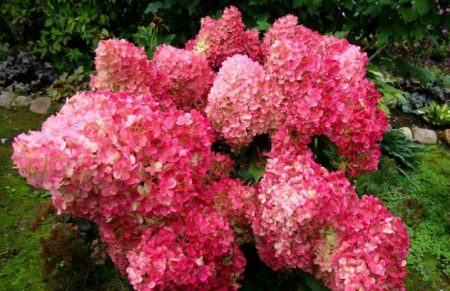
Additional factors affecting the color of inflorescences:
- neutralize acidity by hard watering;
- concrete, pavement coating are a source of leached lime;
- To preserve the resulting color, fertilizers with a high percentage of potassium and a smaller percentage of phosphorus should be used.
How to feed hydrangea on alkaline soils
Hydrangea gives abundant flowering, powerful shrubs on acidic soils, so on peaty soils, sandy soils with litter of overripe leaves, which serve as a source of nutrition and keep the soil moist, it grows without problems.
To create the soil with the conditions necessary for hydrangea can be on any site by applying peat, fallen leaves, sawdust, bark. To bring acidity to 3.5-4.5 units will help watering the soil with acid solutions (citric, oxalic) - 1.5-2 tbsp. l for 10l. The rate for 1 m² - 10l. A solution of acetic and malic acid (9%) is prepared at the rate of 100 g per 10 l.
The soil quickly restores its original properties, so you need to water with acidified water every 10-15 days. Deoxidation is promoted by rain, alkaline or neutral tap water, soil water.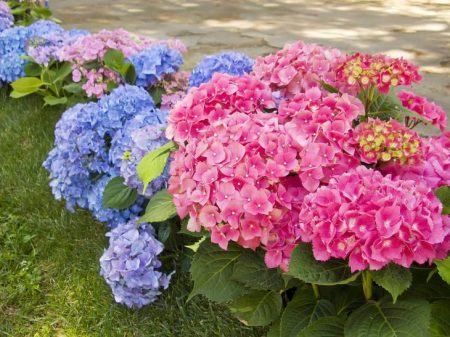
Feeding for different types of hydrangea
Feeding for different types of hydrangeas have differences, which are necessary to take into account to obtain a lush flowering bush.
Types of hydrangeas and top dressing:
- Panicled. This species is characterized by increased resistance to frost, has been growing for more than a dozen years, reaching large sizes. Spring top dressing with superphosphate (60-80g) and potassium (45g) helps the plant during the formation of buds. Nitrogen and microelements in the composition of special fertilizers for hydrangeas help to grow actively.
- Tree-like. This species is demanding on complex top dressing and on the additional introduction of boron, iron, magnesium. In July, you can feed nettle infusion, compost is suitable for autumn fertilizers.
- Large leaf (garden). Superphosphate, potassium fertilizers, urea in equal parts contribute in the spring for active growth. The norm for the bush is 60g. With the onset of summer, a solution of 1 tbsp. l Agricole in 10 liters of water.
From mid-July, in order to maintain active flowering, mineral fertilizers are introduced in lower doses, nitrogen is stopped to be used until spring. In the autumn months, humus (peat) with the addition of potassium-phosphorus fertilizers is used.
Garden hydrangea actively reacts to complex compounds with potassium (23%), nitrogen (18%), phosphorus (5%).
Hydrangea will be grateful for spring dressing and will delight flowering until late autumn.

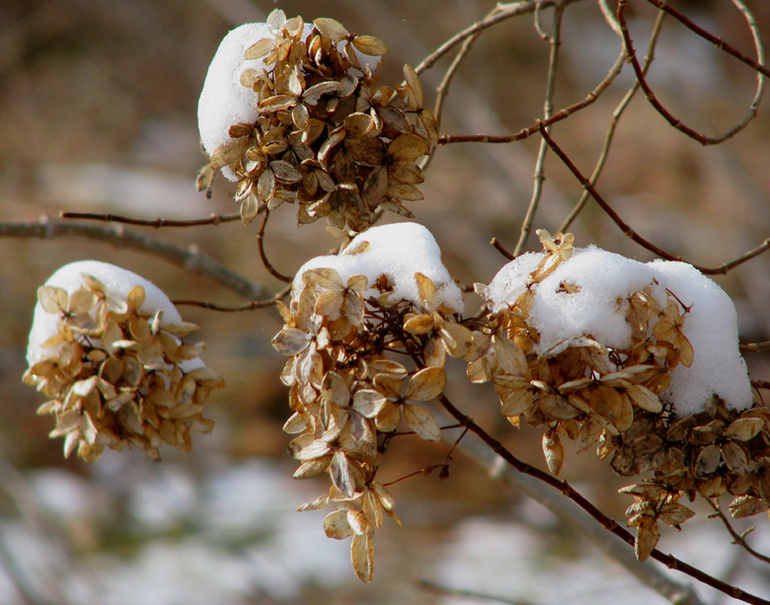
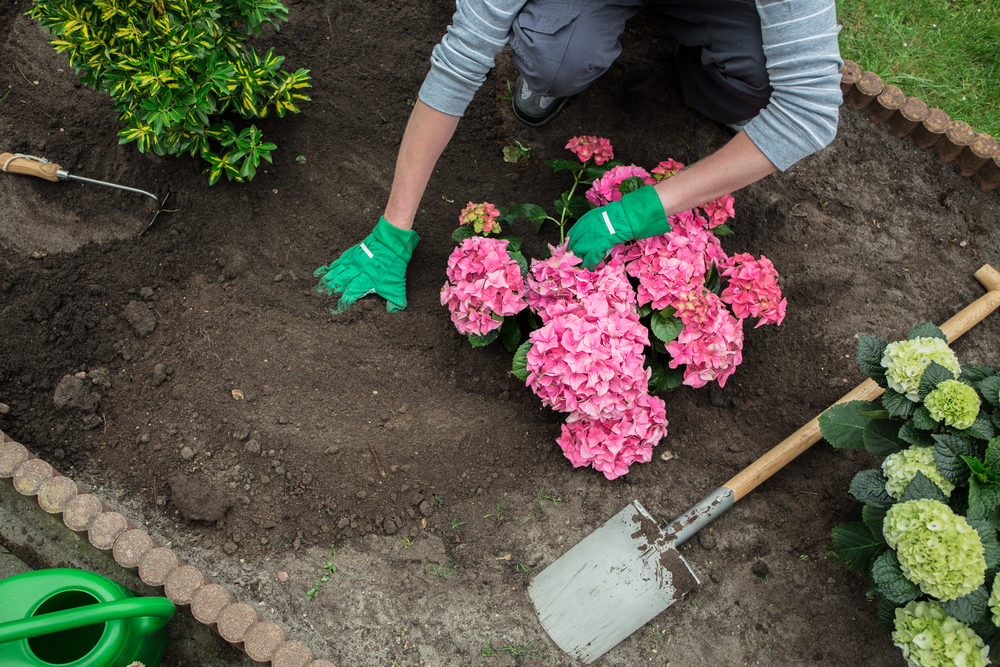

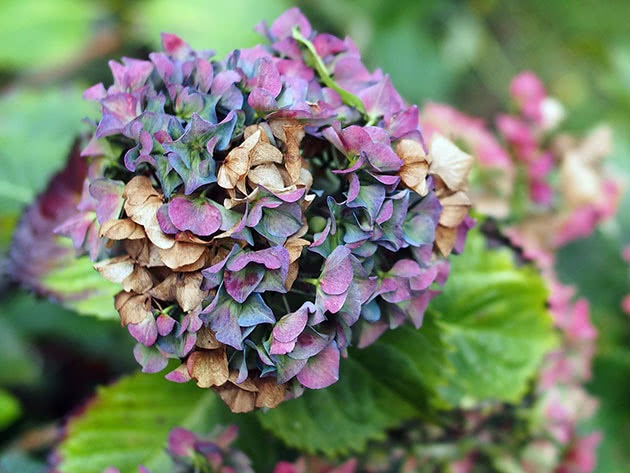 How to propagate hydrangea in the fall: methods, cuttings
How to propagate hydrangea in the fall: methods, cuttings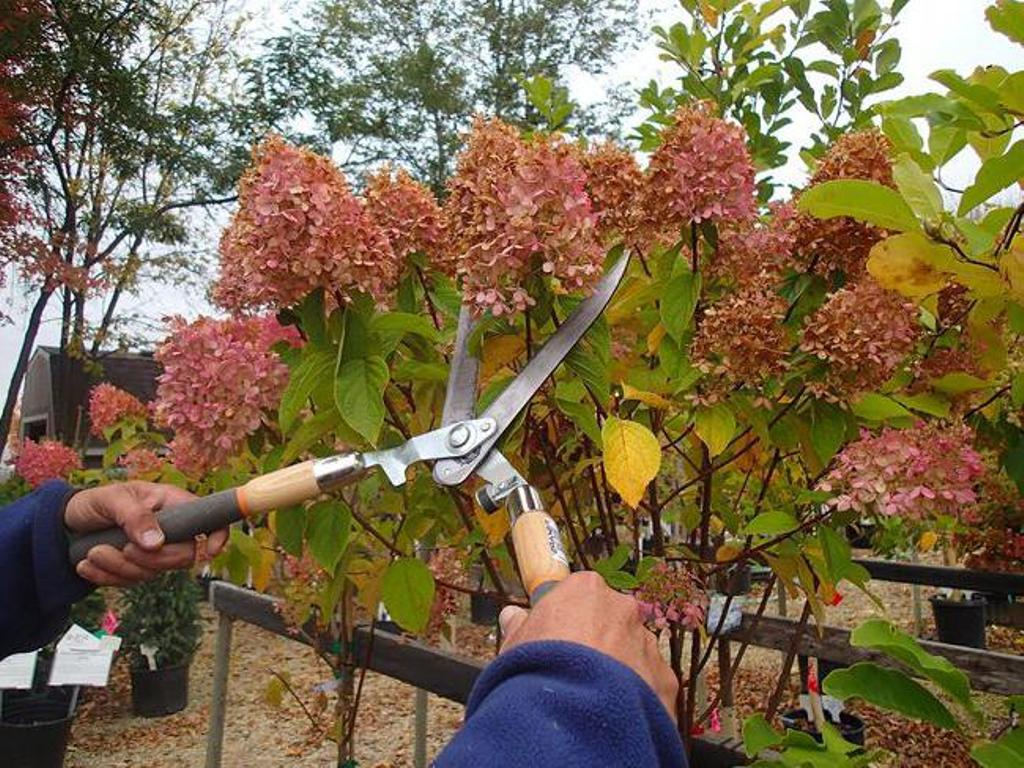 Hydrangea care in the fall and winter preparations
Hydrangea care in the fall and winter preparations How to hide hydrangea in Siberia for wintering
How to hide hydrangea in Siberia for wintering